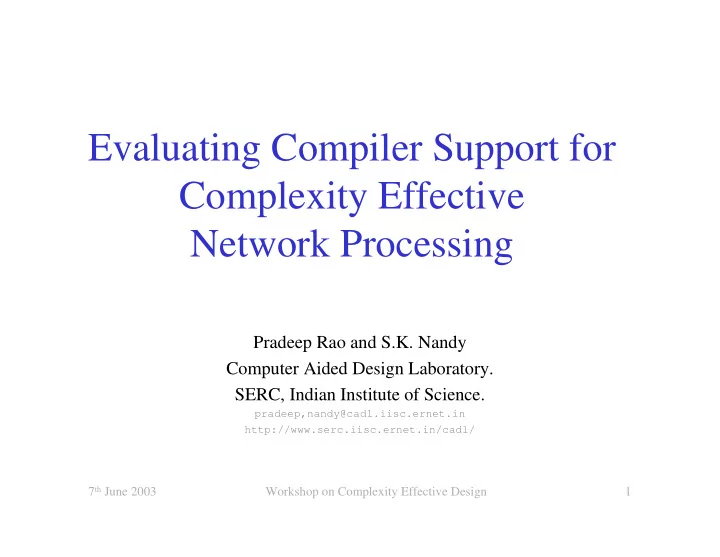

Evaluating Compiler Support for Complexity Effective Network Processing Pradeep Rao and S.K. Nandy Computer Aided Design Laboratory. SERC, Indian Institute of Science. pradeep,nandy@cadl.iisc.ernet.in http://www.serc.iisc.ernet.in/cadl/ 7 th June 2003 Workshop on Complexity Effective Design 1
Outline • Why network processors (NP) ? – Why complexity effective NPs ? • NP design issues • Statically scheduled processors for NPs – Compiler optimizations • Classical • Superblock • Hyperblock – Performance Data 7 th June 2003 Workshop on Complexity Effective Design 2
Network Processors • Why do we need network processors ? – Significant time spent in protocol stack – Increasing data rates • Increased performance requirements – New protocols and services • Software based functionality • Flexible (vs. ASIC) • Faster time to market • Players – Cisco, Intel IXP, IBM PowerNP, Motorola (C-Port) C5, Broadcom, ClearWater ... 7 th June 2003 Workshop on Complexity Effective Design 3
Complexity Effective NPs • Complexity-Effective hardware – Low design, verification and testing times – Impacts time to market – Low power • Fixed power budgets for line cards • Network enabled mobile devices – Performance goals met ? • Performance – Exploit parallelism – Push clock frequencies 7 th June 2003 Workshop on Complexity Effective Design 4
NP Design Issues • System Design: Organization of memory, interconnection, processing element (PE) and its local memory … • Inadequate performance data for the design of future network processors 7 th June 2003 Workshop on Complexity Effective Design 5
Static Scheduling for NPs • Keep hardware simple by offloading complexity onto the compiler • The compiler has a ‘global’ view of the program • Performance data for – In-order superscalar (IOS) – VLIW 7 th June 2003 Workshop on Complexity Effective Design 6
Methodology • IMPACT Toolset (UIUC) • Applications – Checksum computation: crc • Architectures – Deficient round robin – In-order Superscalar scheduling: drr – VLIW – Shortest path computation: • Compiler optimizations dijkstra – Classical – Diffie Hellman public key – Superblock encryption/decryption: dh – Hyperblock – Reed Solomon codec: reed_enc, reed_dec 7 th June 2003 Workshop on Complexity Effective Design 7
The Superblock • Essentially a trace with single entry multiple exits • Reduces bookkeeping required to support side entrances • Code motion with compiler controlled speculation • General speculation model for minimal hardware support. 7 th June 2003 Workshop on Complexity Effective Design 8
The Hyperblock • Adds predicated execution for superblocks 7 th June 2003 Workshop on Complexity Effective Design 9
Application Characteristics • Op-code Frequencies – 40% integer operations • Addition and shifts account for > 80% ops – SB optimizations do not change the op freq. • No additional stress on resources – HB optimizations reduce conditional branches by if- conversion. • Predicate instructions account for 0-37% 7 th June 2003 Workshop on Complexity Effective Design 10
Application Characteristics… • Branch Statistics – Avg. branch prediction accuracy: 92.32%, with < 9% deviation – Branch prediction accuracy for SB and HB are higher 7 th June 2003 Workshop on Complexity Effective Design 11
Application Characteristics… • Block Size – Indicative of potential parallelism – BB Avg: 5 instructions – SB/HB Avg: 13 instructions 7 th June 2003 Workshop on Complexity Effective Design 12
Application Characteristics… • Cache Performance – Effect of SB/HB on cache performance – D$ unaffected – I$, for equivalent cache sizes the miss rate increases by 40% 7 th June 2003 Workshop on Complexity Effective Design 13
Architectural Evaluation… • Speedup plots with perfect caches for VLIW • Up to 2.4x speedup with SB/HB optimization • Predication overhead at low issue widths • Performance gain from HB (over SB) at high issue < 8% • Leveling indicates decrease in processor utilization 7 th June 2003 Workshop on Complexity Effective Design 14
Architectural Evaluation… • Effect of real cache IOS VLIW – Greater impact on VLIW than BB 1.06% 1.08% IOS SB 5.6% 6.8% – However, the performance HB 5.6% 7.4% benefit of IOS over VLIW is less than 1.8%, suggesting VLIW for complexity effective designs – Average network rates of 6.6Gbps @ 500MHz for drr 7 th June 2003 Workshop on Complexity Effective Design 15
Frequency Effects • Increase in memory/FU latency (empirical) • Increase in performance not commensurate with frequency increase – Performance improvement with doubled frequency (B- M1) is < 37%, (M1-M2) < 31% • Need for efficient latency hiding techniques – (SMT, TCP) ? 7 th June 2003 Workshop on Complexity Effective Design 16
Conclusions • This study provides performance data for statically scheduled processors, for networking applications • Operation frequencies differ from SPEC and Media applications – Organization of FU’s • High static branch prediction rates – Make static scheduling attractive for networking applications • Speedup due to SB and HB optimizations can be as high as 2.4 7 th June 2003 Workshop on Complexity Effective Design 17
Conclusions… • HB optimizations improve performance by < 8% – The additional complexity might not be justified • The performance advantage of an IOS over VLIW is less than 1.8% – VLIW being CE might be more attractive • Simulation results show average network rates of 6.6Gbps for drr, at 500MHz for 8-issue VLIW with SB optimization • Need to exploit packet level parallelism 7 th June 2003 Workshop on Complexity Effective Design 18
Thank You 7 th June 2003 Workshop on Complexity Effective Design 19
Recommend
More recommend